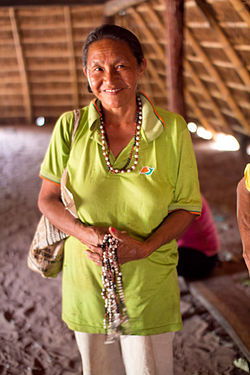Pai Tavytera

Ña Silvia, a spiritual leader of the Pai Tavytera
Indians in Amambay, 2012 |
|
| Total population | |
|---|---|
| (15,000 (2007)) | |
| Regions with significant populations | |
|
|
|
| Languages | |
| Pai Tavytera | |
| Religion | |
| traditional tribal religion, Christianity | |
| Related ethnic groups | |
| Kaiwá |
The Pai Tavytera are an indigenous people of Paraguay and Brazil. They primarily live in Amambay Department in Paraguay and the Brazilian state of Mato Grosso do Sul.
The Pai Tavytera are also known as the Ava, Caaguá, Caingua, Caiwá, Kaa'wa, Kainguá, Kaiowá, Kaiwá, Kayova, Montese, Paï, Paï-Cayuä, Paï-Tavyterä, Paingua, Pan, and Tavytera people. "Paï-Tavytera" is an arbitrary name given to northern Guaraní people of eastern Paraguay. They are closely related to the Guarani-Kaiowá people of Brazil.
The Pai Tavytera speak the Pai Tavytera language, which is a Tupi-Guarani language, division Guarani I. The tribe is rapidly adopting the more mainstream Guarani language.
The Pai Tavytera are mostly likely the descendents of the Itatin Guaraní. They encountered Jesuit missionaries in the 17th century during the reducciones of eastern Paraguay. Many of them resisted assimilation. Following the violent War of the Triple Alliance in the 1870s, their lands were left alone, except for lumberers and harvesters of yerba mate. In recent years, an influx of settlers have disrupted the Pai Tavyter's hunting lifestyle.
The wood altar is the central institution in the religious beliefs of the Pai Tavytera. The altar, called mba’e marangatu in Guaraní is considered a sacred sanctuary and a focal point of the community. The altars usually resides in the homes of the spiritual leaders of the Pai Tavytera Indians or important leaders. The altar is a place where the community gathers around for worship or to discuss matters that are important to the community.
Altars include wooden rods that represents deities or saints. From those rods hangs a gourd used for baptizing children, and the medicine man's gourd rattle, the most important item for the spiritual healer to start his prayer that is a song and a dance to communicate with the spirits. Part of the altar is a taquara bamboo staff, a woman's musical instrument that gives rhythm to the rituals.
...
Wikipedia
